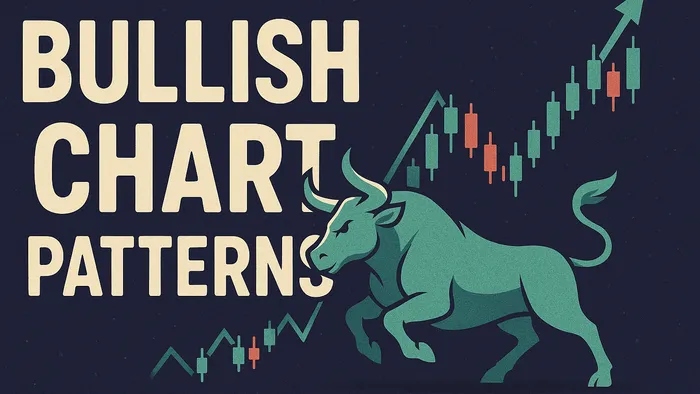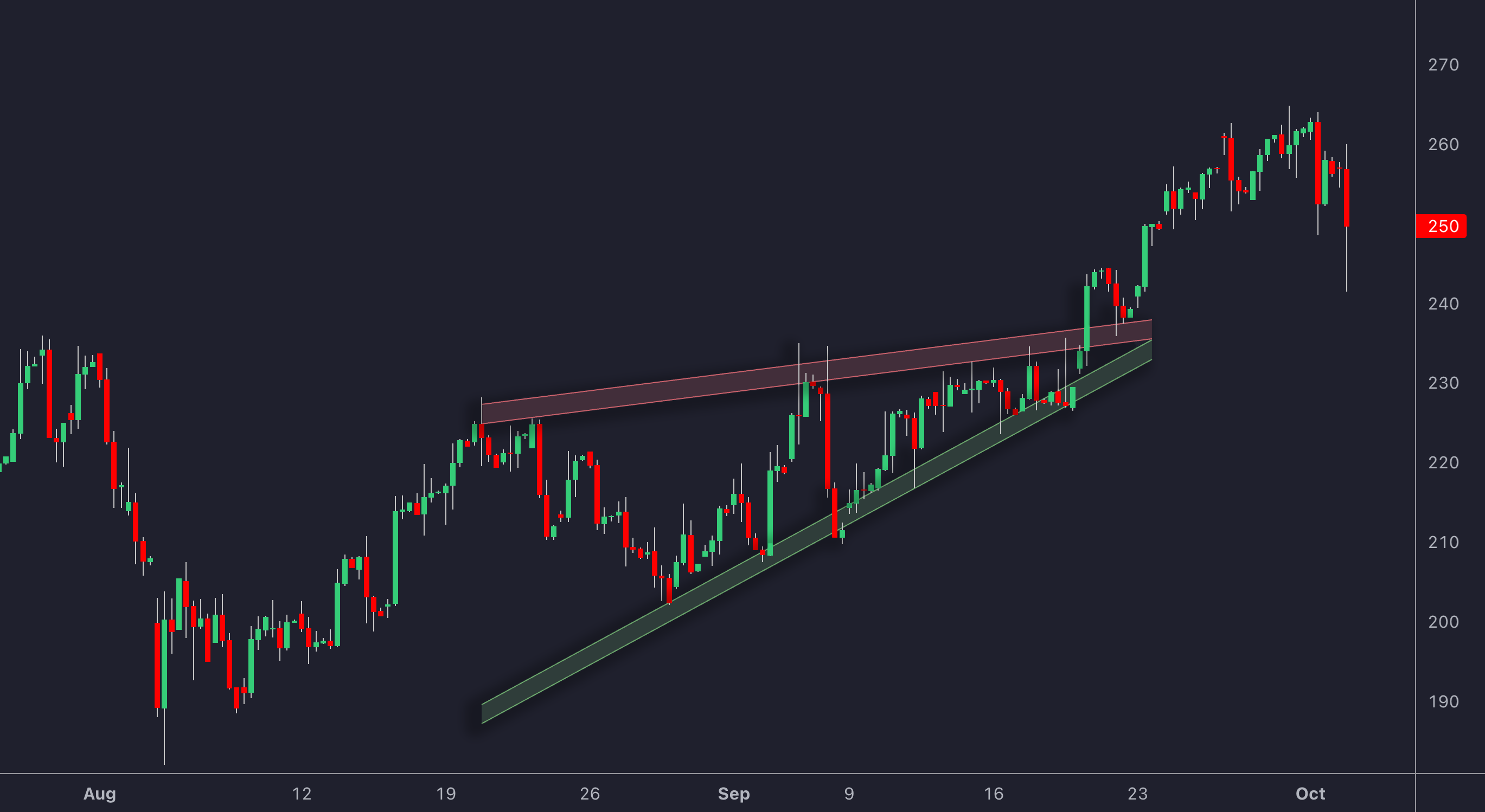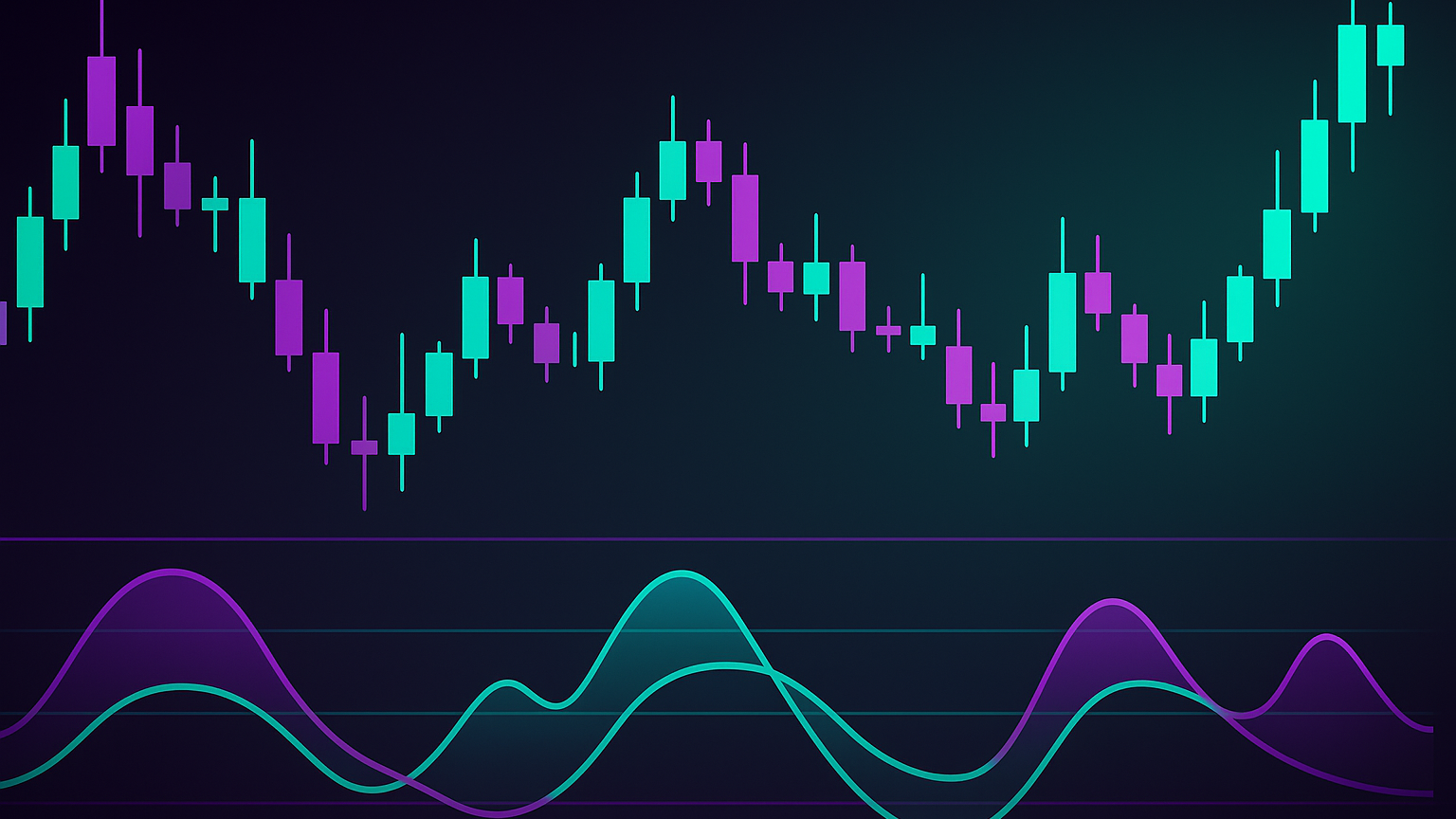Explore bullish chart patterns that signal potential price increases, helping traders make informed decisions and improve trading strategies.
Bullish chart patterns help traders predict price increases by analyzing market trends. These patterns serve as a roadmap for anticipating potential upward momentum, making them valuable for timing trades, managing risk, and setting profit targets. When used in conjunction with volume, market structure, and momentum indicators, pattern-based analysis often provides higher-probability entries compared with relying on price action alone.
Key Takeaways:

- Types of Bullish Patterns:
- Reversal Patterns like the Double Bottom signal a trend shift from bearish to bullish.
- Continuation Patterns like the Ascending Triangle indicate a pause in an uptrend before prices rise again.
- Popular Patterns:
- Double Bottom: W-shaped pattern signaling a reversal.
- Cup and Handle: Teacup-shaped pattern, ideal for continuation trends.
- Ascending Triangle: Formed by rising lows and horizontal resistance, predicting breakouts.
- Trading Rules:
- Enter after confirmed breakouts.
- Use pattern height to set targets.
- Place stop-loss below key support levels.
- Tools to Enhance Accuracy: Combine patterns with indicators like RSI, MACD, and volume analysis. LuxAlgo provides screeners and backtesters on TradingView that automate pattern detection and strategy testing.
Pro tip: Seasoned traders don’t treat chart patterns as a static “buy or sell” recipe. Instead, they continuously monitor confluence between the pattern, momentum oscillators, and macro market context to confirm a trade thesis.
Ascending Triangle Pattern: Technical Analysis Guide
The video above provides a concise breakdown of how to recognize the ascending triangle in real-time and how to manage breakout trades effectively. Study the clip and compare it with your charts to see how the pattern unfolds in different markets.
Basic Pattern Structure
Bullish chart patterns are built around three key elements that help traders predict potential price movements. Mastering these components sets the foundation for evaluating virtually any formation:
Pattern Elements
| Element | Purpose | Importance |
|---|---|---|
| Trendlines | Connect price points to show direction | Define the pattern's boundaries |
| Support Levels | Highlight where buying pressure halts a decline | Indicate buyer strength |
| Resistance Levels | Show the ceiling created by selling pressure | Point to potential breakout areas |
| Volume | Confirms the strength of price movement | Ensures the pattern's reliability |

Notice how volume often contracts while a pattern forms and then expands dramatically on breakout. This “quiet-to-loud” shift reflects accumulation by informed traders before a decisive move.
Pattern Types: Reversal and Continuation
Bullish patterns are divided into two main categories, each offering unique insights into market trends.
Reversal Patterns
These patterns suggest a downtrend is ending and an upward move is beginning. A classic example is the double bottom pattern [1][3]. Reversals tend to work best when the broader market sentiment also shifts, so monitoring index futures or sector ETFs can add context.
Continuation Patterns
These formations signal a brief pause in an ongoing uptrend. The ascending triangle is a well-known example of this type [1][3]. Continuations often allow traders to pyramid into a position by adding size on each breakout.
Accurate identification of trendlines, support levels, and resistance levels is critical for assessing the reliability of these patterns [1][3]. Traders frequently validate pattern boundaries by observing how many times price “touches” a level without breaking through.
Common Bullish Patterns
The following setups appear across all liquid markets, from crypto to blue-chip stocks, and are favored because of their clarity and well-researched probabilities.
Double Bottom
The Double Bottom pattern forms a “W” shape and indicates a potential reversal from a downtrend. It develops through two tests of a support level, signaling strong buyer interest.

Practical example: In March 2024, shares of XYZ Corp. printed a textbook double bottom near USD 45. After the neckline break on above-average volume, price rallied 18 % within two weeks, validating the reversal signal.
Key features:
| Component | Description | Trading Insight |
|---|---|---|
| First Trough | Initial dip to support level | Suggests early buyer activity |
| Second Trough | Retest at similar price level | Confirms support strength |
| Neckline | Resistance between troughs | Breakout confirmation point |
A breakout above the neckline, especially with higher trading volume, confirms the pattern’s validity and often precedes a strong momentum burst as short-sellers cover positions.
Cup and Handle
First popularized by William O’Neil in the 1980s, this pattern looks like a teacup with a slight dip (the “handle”) on the right. It has shown a 65 % success rate in bull markets, increasing to 68 % in bear markets [3], making it a useful approach for traders aiming for statistical advantages.

Why it works: The “cup” represents a rounded consolidation that flushes out weak hands, while the short handle shakes out late buyers. When price finally pierces the handle’s resistance, the move is fueled by fresh demand and a lack of overhead supply.
Key components:
| Component | Description | Trading Significance |
|---|---|---|
| Cup Depth | Retraces about 1/3 of prior uptrend | Validates the pattern |
| Handle | Develops over a short period | Indicates consolidation |
| Breakout | Accompanied by high volume | Confirms the pattern's completion |
Traders often measure the “cup depth” to forecast the post-breakout target, ensuring the reward-to-risk ratio is attractive before committing capital.
Ascending Triangle
The Ascending Triangle is a continuation pattern often seen during established uptrends. It forms as prices create a horizontal resistance level while progressively making higher lows.
Trading tip: Breakouts that occur after the triangle has narrowed to roughly two-thirds of its original width are statistically more reliable, as price has had time to coil and build pressure.
Key features:
| Element | Description | Trading Implication |
|---|---|---|
| Upper Boundary | Horizontal resistance | Marks breakout level |
| Support Line | Rising lower boundary | Reflects growing buying pressure |
| Breakout | Accompanied by volume increase | Indicates entry opportunity |
Trading with Bullish Patterns
Once you’ve spotted high-probability patterns, the next step is executing with precision. The most successful traders treat each setup as a repeatable business decision, not a one-off gamble.
Entry and Exit Rules
Enter trades after a confirmed breakout above resistance. Use the pattern’s height to set your price targets. For example:
- Cup and Handle: Measure the cup’s depth and project it from the breakout point.
- Double Bottom: Use the height from the troughs to the neckline.
- Ascending Triangle: Measure the height from the triangle’s base to its resistance level.
| Pattern Type | Target Calculation |
|---|---|
| Cup and Handle | Cup depth projected from breakout |
| Double Bottom | Height from troughs to neckline |
| Ascending Triangle | Height of triangle from base to resistance |
Some traders add a second, more distant profit target to capture extended trends while trailing a stop on the remaining portion of the position.
Stop-Loss Rules
Risk management is just as important as entry strategies, and setting stop-loss levels is key to protecting your capital. Here’s where to place them:
- Cup and Handle: Below the lowest point of the handle.
- Double Bottom: Below the second trough.
- Ascending Triangle: Below the most recent higher low.
| Pattern | Stop-Loss Placement |
|---|---|
| Cup and Handle | Below handle low |
| Double Bottom | Below second trough |
| Ascending Triangle | Below last higher low |
To manage risk effectively, limit your exposure to 1-2 % of your trading capital per trade [2][3]. Position sizing calculators or the risk module inside LuxAlgo’s backtesters can automate this process.
Pattern and Indicator Combinations
Combining patterns with technical indicators can strengthen your trading decisions. Some useful combinations include:
- RSI (Relative Strength Index): Readings above 50 during pattern formation suggest bullish momentum, while bullish divergences near pattern support can foreshadow an upside breakout.
- MACD: Crossovers above the signal line confirm breakout reliability and may help traders stay in a trade during extended trends.
- Volume Profile: Highlights key support levels within the pattern where institutional orders cluster.
- Alert Scripting: Automates breakout notifications across LuxAlgo’s toolkits, enabling traders to focus on execution rather than constant chart-watching.
These indicators, when used alongside volume analysis from the Basic Pattern Structure, can provide additional confidence in your trades.
Pattern Recognition Software
Algorithmic scanners dramatically shorten the time needed to locate patterns across hundreds of instruments. LuxAlgo’s toolkits on TradingView overlay pattern outlines in real-time, while statistical readouts show the historical hit rate of each setup.

Pattern Scanning Tools
The Price Action Concepts and associated screeners can analyze dozens of chart patterns with high accuracy. Key capabilities include:
| Feature | Purpose |
|---|---|
| Multi-timeframe Scanning | Identifies patterns across various trading timeframes |
| Custom Parameters | Allows traders to fine-tune settings to match their style |
| Visual Overlays | Displays patterns directly on the charts for quick analysis |
Users can filter scan results by “confidence score,” focusing only on setups that meet strict volume, momentum, and trend criteria.
Testing Tools
Historical strategies can be validated with LuxAlgo’s complimentary S&O Backtester and OSC Backtester, while the AI Backtesting platform (overview, documentation) analyzes thousands of patterns to assess reliability under different market conditions [4]. The platform even suggests optimized stop-loss and take-profit levels based on the most profitable historical outcomes.
Trading Communities
Engaging with trading communities helps traders refine their skills and learn from others. These forums offer opportunities to:
- Share techniques for identifying patterns.
- Discuss live trading opportunities.
- Compare backtesting results and insights.
When combined with stop-loss strategies and target-setting methods from earlier sections, these resources provide a solid foundation for technical trading success.
Summary
Main Points
Pattern analysis in trading has evolved from static textbook formations to dynamic, indicator-enhanced models. According to research, traders who incorporate bullish patterns with volume and momentum filters experience an average 12.3 % increase in annual returns compared to those who skip chart analysis [4].
Here are the key elements for successfully trading bullish patterns:
| Component | Strategy |
|---|---|
| Pattern Validation | Use volume confirmation alongside technical indicators |
| Risk Management | Set clear stop-loss levels and manage position sizes |
| Pattern Recognition | Combine software scanning with manual checks |
This blend of traditional charting methods and modern technology has reshaped how traders spot and act on patterns. For access to advanced features, review LuxAlgo’s pricing plans.
Getting Started
Ready to put these ideas into action? Start by analyzing historical data to sharpen your ability to recognize patterns without risking real money. A simulated trading journal helps track results and refine rules before moving to a live account.
Follow a structured process for implementation:
| Phase | Key Action |
|---|---|
| Scanning | Conduct daily market reviews |
| Validation | Perform technical analysis |
| Execution | Plan your entry and exit points |
Use the pattern identification techniques discussed earlier, especially volume confirmation methods from the Basic Pattern Structure section. Focus on mastering one pattern type at a time before expanding to others. Consistency is key to building a reliable trading strategy.
FAQs
Which of the following patterns is a bullish reversal pattern?
The Double Bottom pattern is a well-known bullish reversal signal in technical analysis. This W-shaped pattern appears at the end of a downtrend and suggests a possible shift to bullish market sentiment once the price breaks above the resistance level (known as the neckline) between the two troughs.
For example, in May 2023, Apple Inc. (AAPL) exhibited this pattern, leading to a volume-backed breakout and a 28 % price rally over six weeks.
Key elements of the Double Bottom pattern include:
- An initial test of support
- A retest at a similar price level
- A resistance level (neckline) between the two troughs
When trading this pattern, it’s crucial to follow the 1-2 % capital risk rule discussed in Trading with Bullish Patterns. The pattern becomes more reliable when breakouts are supported by increased trading volume and broader market trends. To maximize results, combine volume confirmation and stop-loss strategies as outlined in Trading with Bullish Patterns.
References
- Investopedia: Using Bullish Candlestick Patterns to Buy Stocks
- TrendSpider: Bullish Chart Patterns
- LiteFinance: Bullish Candlestick Patterns
- XS Blog: Stock Chart Patterns
- LuxAlgo Ultimate RSI Indicator
- LuxAlgo Adaptive MACD Indicator
- LuxAlgo Blog: Reversal Spotting Made Easy
- LuxAlgo Home
- LuxAlgo AI Backtesting Platform
- LuxAlgo Liquidation Levels Indicator
- LuxAlgo Volume Profile Maps
- LuxAlgo Screeners
- LuxAlgo OSC Backtester Documentation
- LuxAlgo S&O Backtester Documentation
- LuxAlgo Alert Scripting Guide
- Signals & Overlays Toolkit Overview
- Price Action Concepts Toolkit Overview
- Oscillator Matrix Toolkit Overview
- Oscillator Matrix Reversal Signals
- AI Backtesting Assistant Documentation
- LuxAlgo Pricing Plans









